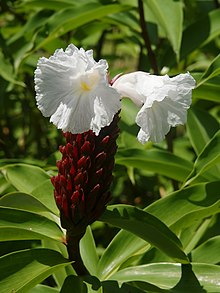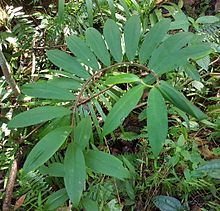Cheilocostus speciosus
| Crêpe ginger | |
|---|---|
 |
|
| Cheilocostus speciosus from Tortuguero, Costa Rica | |
 |
|
| Wild Cheilocostus speciosus from Bukidnon, Philippines | |
| Scientific classification | |
| Kingdom: | Plantae |
| Clade: | Angiosperms |
| Clade: | Monocots |
| Clade: | Commelinids |
| Order: | Zingiberales |
| Family: | Costaceae |
| Genus: | Cheilocostus |
| Species: | C. speciosus |
| Binomial name | |
|
Cheilocostus speciosus (J.Konig) C.Specht |
|
| Synonyms | |
many more |
|
many more
Cheilocostus speciosus, or crêpe ginger, is a species of flowering plants in the genus Cheilocostus. It is native to southeast Asia and surrounding regions, from India to China to Queensland, It is especially common on the Greater Sunda Islands in Indonesia. It is also reportedly naturalized in Mauritius, Réunion, Fiji, Hawaii, Costa Rica, Belize, Melanesia, Micronesia, and the West Indies. It is widely cultivated as an ornamental
Cheilocostus speciosus differs from the common ginger by having only one row of spirally arranged leaves. The species reproduces vegetatively by rhizome, and birds disperse the seeds when they feed on the fruits.
This plant is cultivated in India for its medicinal uses, and is cultivated elsewhere as an ornamental. In some areas Cheilocostus speciosus is introduced and has become an invasive species.
The habitat where this species is found is roadside ditches and low-lying areas in the forest. The flowering season starts after the rainy season, from October to December.
The plant has many historical uses in Ayurveda, where the rhizome has been used to treat fever, rash, asthma, bronchitis, and intestinal worms. It is mentioned in the Kama Sutra as an ingredient in a cosmetic to be used on the eyelashes to increase sexual attractiveness. It is used to treat kidney problems and other urinary problems in Mizo Traditional Medicine.
...
Wikipedia
